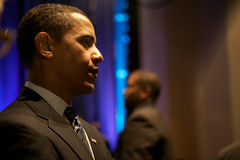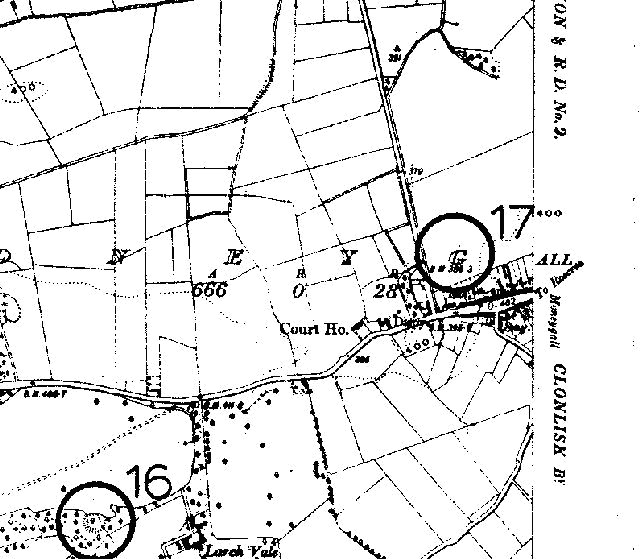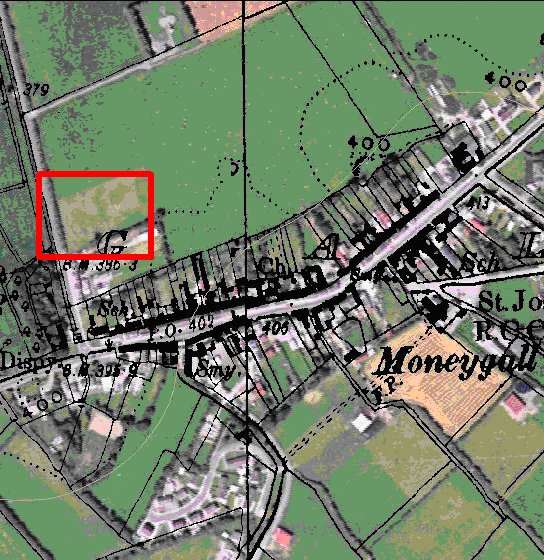Obama Archaeology
Shamelessly piggybacking on the crowning of King Obama of the U S and A this coming Tuesday (who we assume won’t be continuing the ‘One World Government’ policies of the tiptoe totalitarian ‘scientific technocrat’ puppet George W. Bush) and continuing in the now well established Old Irish tradition of taking advantage of any tenuous US Presidential connections to the Auld Sod, here’s some of the results of a test excavation we completed in Obama’s homestead of Moneygall, Co. Offaly.
This is a long post, so for those in a rush, there’s a short summary at the end….

G.W. – Apparently descended from Niall of the Nine Hostages, just like most men from the West of Ireland
Photo – White House photo by Eric Draper. (cc)
Now, despite the fact that the Kearney family (Obama’s Irish forebears) appear to have originated in Cashel, Co. Tipperary, his Great Holyness Barack’s most direct lineage to Ireland derives from Moneygall, Co. Offaly and a site investigated by Billy in 2008 is located there (this mildly cynical tone isn’t going to ruin our chances of an invitation to the White House Archaeology Room to present a powerpoint of The Prez’s archaeological heritage to him, is it?).

B.A. – Probably descended from Niall of the Nine Hostages, just like most men in the West of Ireland
Photo owned by Obama-Biden Transition Project (cc)
Barack Obama’s Irish links have been traced to the Kearney family from Moneygall, and specifically his 2nd (or third depending on which source you read) great-grandfather Falmouth or Fulmouth Kearney who left for America in 1850, when he was 19. The Obama Irish origins are well documented on the web – PaddyAnglican has lots of pertinent info (and is travelling to the inauguration) on his blog.
I should mention that our site may have pre-dated the arrival of the Kearneys to Moneygall, and we haven’t been able to locate exactly where Kearney’s Garden is (we think it’s to the south of the town). Nonetheless, the enclosure we describe below would have been a landmark locally and would have been well known to old Fulmouth before he emigrated to the New World. And, well, we didn’t recover anything to accurately date the site, and we really only got an opportunity to map and put a couple of test trenches into it, and we haven’t exactly got anything groundbreaking to report, but hey, it’s Obama archaeology, just the smallest glimpse so far, the rest is preserved in situ and remains for future generations to judge. We apologize in advance for the obvious link baiting.
So, where do Obama’s ‘Folks’ (with a Hat Tip to GW, we’ll stay a bit folksy for this blog post) come from, and what was it like?
Well, Ireland has no written history from before the arrival of Christianity, so it’s to archaeology, mainly, that we must look for answers about the prehistoric period. And Lough Boora in Co. Offaly provided archaeologists with evidence of settlement in the county 9000 years ago (the Mesolithic period). Excavated in the late 70’s the site comprised an ancient post-glacial lakeshore settlement and demonstrated that the interior of Ireland was settled earlier than was thought previously. These early ancestors of the President-Elect are thought to have lived in small circular huts constructed from saplings inserted into the ground and bent over to form dome-shaped timber structures with central fire hearths and animal skin roof coverings. Their diet was likely made up of pig, wild fowl, eels and locally gathered fruit. Their tools were made of chert, a locally sourced black stone similar to flint. The landscape at the time was forested with Oak, Elm and Pine.
The Obama/Kearneys and the Great Change
By about 4000BC Obama’s folks would have experienced great change with the evolution from hunter gathering to farming with supplemental foraging (the Neolithic Period – Can we farm, Yes We Can! – sorry!). This is when the Obama/Kearneys (let’s call them the OK’s from here on in, shall we?) would have first encountered the joys of bread and beer. This is also the time of the great megaliths, the best known and most visible monuments of the period. At a time where the expected life span was 30 years there appears to have been a greater concern with the dead and the ancestors, perhaps giving rise to this monumental funerary culture. Although there is little physical evidence for the Neolithic in Offaly, it has been suggested that the mound on Croghan Hill and the large burial mound at Forelacka in the Slieve Bloom mountains may conceal megalithic tombs. This too is the period of the first great human intervention in the dense woodland which still dominated our landscape.
The OK’s and metal
Around 2500BC a revolution in technology gradually made stone tools redundant and Copper and Bronze became the source tool material du jour (just like ‘entrepeneur’, the French have no words for ‘du jour’ as far as I know) and the OK family became part of the new metal-working society. This period is known as the Bronze Age and lasted from 2000BC to around 600BC. During this period it is thought that Irish society changed from an agrarian agricultural economy to a hierarchal warrior aristocracy (whether the OK’s were part of the ruling elite is obviously unknown, but as far as the Countercurrents blog is concerned Obama is certainly part of it now). This ruling elite may have been similar to the New York/Washington liberal elite of today, except with a propensity to chop their enemies heads off, eat horses whole and insist that you suck their nipples (for more on horse eating, nipple sucking and head-chopping see earlier entries on this blog). During the Bronze Age, the blanket bogs of Ireland began to grow and gradually dominate the landscape (perhaps due to climate change or climate change combined with the adverse effects of deforestation and farming in the Neolithic – although we all know that there’s no such thing as climate change – and if there is it’s certainly not influenced by humans – so the bogs are not our fault). Several important Gold hoards from this period have been found in Offaly, the most famous being the Dowris Hoard found near Birr in the 19th century.
Of course, one of the most widespread monuments from this time is the Fulacht Fiadh, a site type which is well documented on this blog.
Around 500BC, Iron and the Celts appeared and gradually iron technology displaced the use of Bronze – this period is, surprisingly, known as the Iron Age! Once thought of as an actual physical invasion by the Celts, it’s now thought more likely that the Celts were cultural colonizers as opposed to embodying a large invasion force, a theory which is supported by genetic evidence. The OK’s would again have witnessed great societal changes with the emergence of a chariot driving warrior aristocracy engaged in cattle raiding and warfare and new art and adornment styles.
By 431, the Christians had begun arriving, with Palladius’s appointment as bishop to the Irish. Palladius was quickly followed by other missionaries such as Patrick.
According to O’Brien:
In the Midlands, the Ui Néill tribe which claimed inheritance to Niall of the Nine Hostages had begun to expand its power base from the North by the fifth century. They claimed the kingship of the region spanning from Offaly to the North of Ireland with the Hill of Tara as their symbolic centre of kingship. The hill was to become the political centre of their rule in Ireland. At the same time the Eóganacht family was expanding its power from the south of Ireland, up into modern South Offaly, claiming the kingship of Munster. The Eóganacht’s power base was the Rock of Cashel from where they claimed authority to rule over the province of Munster.
Obviously, Offaly as a region did not exist during this period but as an area of land it was placed on a frontier zone between these two ruling tribes. Eventually in the later medieval period this rivalry would lead to the claim for the High Kingship of Ireland with rival kings from different provinces fighting for this mystical title.
‘So what?’, I hear you saying, ‘cut to the chase – what was this site and what did you find?’ (clever literary device to skip Christianity and the later History of Ireland and Offaly, Eh?).
Well, this is probably roughly around the date of the enclosure depicted below on the Sites and Monuments Map, situated on high ground on the NW side of Moneygall town. Examination of the aerial photographs revealed that within the site there was a distinct penannular cropmark indicating the presence of the ditch for the enclosure in the eastern half. Also visible within the interior of the enclosure was a circular green patch. A local commentator living adjacent to the site recalled that this area had been dug out in the 1950’s leaving a circular depression approximately 5ft deep by 12ft wide.
And Now for the Science Bit:
The site was greenfield of good pastureland and sloped naturally from West to East. In the vicinity of the recorded monument (RMP OF046:017) towards the North East corner of the site was a sub-circular elevated area with a gradual slope. Topsoil stripping exposed the line of the enclosing ditch for the monument. The ditch was defined by a wide fosse filled with a brown loam, that measured approximately 5.8m wide at the top. A test trench excavated through the feature showed a stratigraphy containing an upper deposit of brown silt overlying a layer of charcoal enriched material and a base deposit containing some animal bone. Within the interior of the enclosure the topsoil cover was very shallow with no immediate features evident. The site has an external E/W diameter of approximately 45m and within the field a N/S extant of 38m. It was agreed that the monument would be preserved in situ by covering the exposed archaeological remains in geo-textile and raising the existing levels to act as a buffer between the archaeological deposits and a proposed housing development with a number of sections hand dug across the width of the fosse.

RMP showing location of site - 17
Excavation took place over a two week period. During this period three ditch trenches were excavated and recorded. A further 17 separate features were identified and half sectioned throughout the site, all of which were found outside the enclosure. Of these 17 features, excluding the ditch, 7 were identified as being archaeologically significant. They included 5 pits, a linear feature and a rectangular pit with 4 corner postholes filled with charcoal enriched silt and fire cracked stones.

Aerial photo showing site location
Excavation of the three trenches through the ditch of the enclosure to the W, E and S of the monument exposed an extant defensive fosse generally 6m wide at the top, with sloping sides (55˚ on average) breaking to an uneven base. The ditch had an average depth of 1.5m and was broadly ‘U’ shaped in profile. Stratigraphically the exposed profiles were generally uniform consisting of upper siltier fills overlying lower sandier fills. The only finds retrieved were fragments of animal bone, found in the lower contexts. The stratigraphy would be consistent with natural silting at the base of the trench over a prolonged period followed by the levelling of the monument in the 19th century and the infilling of the remains of the ditch with the internal bank material. Despite the destruction of the monument and subsequent agricultural activity the enclosing defensive fosse survives extant below ground.
Although limited in scope and disappointing in terms of the material recovered, the excavation afforded us a glimpse into the nature and function of the site, and an opportunity to at least record the depth and extent of the feature, a feature which would have been extant and visible in the Kearneys time, with probable mythical/superstitious meaning to all the Kearneys and their neighbours.
If anyone from the Obama organisation would like Billy and I to present our findings we’d certainly entertain the idea.

Photo owned by Obama-Biden Transition Project (cc)
SUMMARY: Barack Obama’s Irish ancestors came from Moneygall, Co. Offaly. They left there a long, long time ago. Fulmouth Kearney of Moneygall was Obama’s 3rd Great Grandfather and he went to America. We dug some test trenches in a field in Moneygall. This post is our shamelessly tenuous link to Obama’s inauguration on Tuesday. We found very little on the site. That’s all really. We would be happy to present our findings in the White House.
With a big hat tip to Caimin O’Brien...

This entry was posted on Monday, January 19th, 2009 at 12:06 am. It is filed under About Archaeology and tagged with Obama genealogy, Obama Irish origins, Obama's Irish roots, Obamas Irish ancestors.
You can follow any responses to this entry through the RSS 2.0 feed.








One of your ex-pats (a decendent of Niall of the Nine Hostages) pointed me to this site. I would like to say how impressed I am with the speed with which you were able to not only find, link, and bullshit your way into Obama’s inauguration (or should that really be O’Bama?). I would also like to extend (in this new feeling of openness and White House access) an invitation for you to come to the U.S. and present your findings!
Incidentally, I feel that you both should plan a visit to the Wild West. Strictly research, of course.
http://www.muddyrivermashers.com/
This post is completely brilliant and I’ve linked it in three places. Hope you don’t mind!
@Jen – I strongly suspect that you may not speak for Obama. But, if you do, then we would of course be delighted to come.
@SS – We certainly intend on having a beery Wild West expedition at some stage in the not so distant future.
@Colleen – Thanks for your very nice things that you say.
Well in my defense, Declan, I didn’t say you could present at the White House.
[…] Obama Archaeology Obama’s Irish ancestors and the prehistory of his family […]
[…] 22, 2009 Obama is descended from the Kearneys of Moneygall, Co. Offaly. My maternal grandmother was a Kearney from County Meath. But, hey, all the Kearneys probably […]